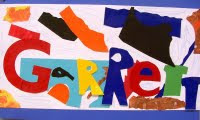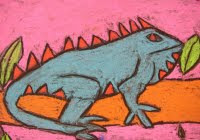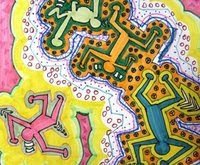Here are my top five art lessons to begin fifth grade with....
Fifth Grade
 To learn student names and jump right into creative nirvana, begin the year with Matisse Inspired Name Panels. I love the process of this project. It's not easy to free-form cut initials out of paper, but that's what I expect. I demonstrate a few tips and most kids will grasp the concept quickly. Some won't but they'll come up with other solutions that are quite clever. However they manage, these name panels are a fun, colorful project to kick off the year. They look really cool on the walls, too.
To learn student names and jump right into creative nirvana, begin the year with Matisse Inspired Name Panels. I love the process of this project. It's not easy to free-form cut initials out of paper, but that's what I expect. I demonstrate a few tips and most kids will grasp the concept quickly. Some won't but they'll come up with other solutions that are quite clever. However they manage, these name panels are a fun, colorful project to kick off the year. They look really cool on the walls, too.Time: 2 50-minute classes (try not to extend this lesson...encourage them to finish it up. It's hard to store all the itty bitty pieces.)
Supplies: 10" x 16" white paper (yes, it's narrow. You'll need to cut these from a full sheet of 12" x 18" paper), colored paper scraps (the more variety the better), glue sticks and scissors, colored paper sheets for mounting.
 I love, love, love this project. It's adapted form an Arts Attack Video lesson. The Rouault Inspired Royalty Painting is a fantastic lesson in drawing without a pencil. Students create the whole painting using just a paint brush. Some kids understandably freak out once they learn this, but after a quick demo, they are eager to start. The results are beautiful and surprisingly enough, it's a fast project. I tell you, eliminate a pencil and it doesn't take long for the artist within to emerge!
I love, love, love this project. It's adapted form an Arts Attack Video lesson. The Rouault Inspired Royalty Painting is a fantastic lesson in drawing without a pencil. Students create the whole painting using just a paint brush. Some kids understandably freak out once they learn this, but after a quick demo, they are eager to start. The results are beautiful and surprisingly enough, it's a fast project. I tell you, eliminate a pencil and it doesn't take long for the artist within to emerge!Time: 2 50-minute sessions (not everyone will finish, but most will)
Supplies: 12" x 18" white paper, photocopy the face cards from a deck of cards (enlarge them), tempera paint (red, blue, yellow, green, white and orange), watered down black tempera paint, small paintbrush and medium paintbrush.
 In keeping with the theme of colorful projects, the next lesson I would do is Chalk Lizards. I don't use much chalk in the lower grades, but I really bring it out for the upper grades. They seem more able to cope with the mess. Show the kids how to draw a simple lizard or chameleon, use only a black oil pastel and fill in with chalk. How easy is that? This project has that WOW factor, so get ready for the compliments.
In keeping with the theme of colorful projects, the next lesson I would do is Chalk Lizards. I don't use much chalk in the lower grades, but I really bring it out for the upper grades. They seem more able to cope with the mess. Show the kids how to draw a simple lizard or chameleon, use only a black oil pastel and fill in with chalk. How easy is that? This project has that WOW factor, so get ready for the compliments.Time: 2 50-minute sessions
Supplies: 12" x 18" black drawing paper, colored chalk, black oil pastel
 Slow things down a bit and bring out the markers. This Drawing inspired by Keith Haring is a popular project with fifth graders. This lesson originated from an article in Arts and Activities magazine, but I don't remember which one. I tried it long after I had clipped the article and was amazed at how much the kids embraced the energy of this project. Its a great lesson because kids relate to it and because it has an easy prep. Basically just paper and markers!
Slow things down a bit and bring out the markers. This Drawing inspired by Keith Haring is a popular project with fifth graders. This lesson originated from an article in Arts and Activities magazine, but I don't remember which one. I tried it long after I had clipped the article and was amazed at how much the kids embraced the energy of this project. Its a great lesson because kids relate to it and because it has an easy prep. Basically just paper and markers!Time: 2 50-minute sessions (this is another great project to begin the year with as students can pull it from their portfolio anytime throughout the year to finish it.)
Supplies: 12" x 15" white drawing paper (trimmed from a 12" x 18" sheet), markers in broad and fine tip.
 I have to stop doing this one..but the Picasso Inspired Oil Pastel Portrait is just too good. Absolutely every student is successful with this lesson. It's easy, colorful, expressive and relatively quick. Again, the lesson originated from an article in Arts and Activities Magazine a few years back and it's been a favorite of mine ever since.
I have to stop doing this one..but the Picasso Inspired Oil Pastel Portrait is just too good. Absolutely every student is successful with this lesson. It's easy, colorful, expressive and relatively quick. Again, the lesson originated from an article in Arts and Activities Magazine a few years back and it's been a favorite of mine ever since.Time: 2 or 3, 50-minute sessions
Supplies: 12" x 15" white drawing paper, oil pastels including black.
There you have it. My top five. Of course I love all of my lessons posted, but if I could chose just five, these are the ones I would start with. Good Luck!
Next up...sixth grade!

No comments:
Post a Comment
Well, what do you think? I love hearing how you adapted the art projects. Did it work? Any pitfalls? Or, if you'd like, just share your thoughts.